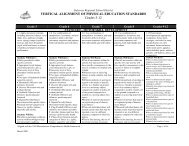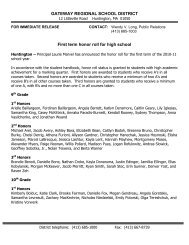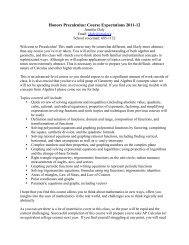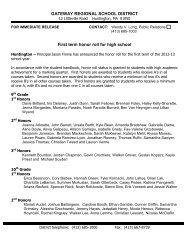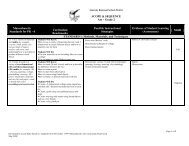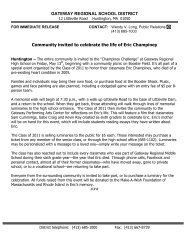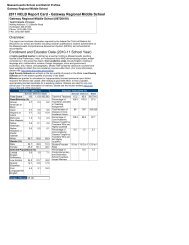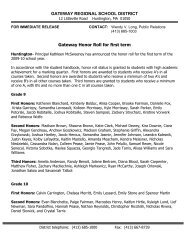Version 2.0 Budget Executive Summary - Gateway Regional School ...
Version 2.0 Budget Executive Summary - Gateway Regional School ...
Version 2.0 Budget Executive Summary - Gateway Regional School ...
Create successful ePaper yourself
Turn your PDF publications into a flip-book with our unique Google optimized e-Paper software.
<strong>Gateway</strong> <strong>Regional</strong> <strong>School</strong> District<br />
FY’10 <strong>Budget</strong>, <strong>Version</strong> <strong>2.0</strong><br />
<strong>Executive</strong> <strong>Summary</strong> and <strong>Budget</strong>ary Goals<br />
The FY 2010 <strong>Budget</strong> document is a planning tool for the 2009-2010 school year. At this<br />
point in time it is a preliminary document, particularly the revenue estimates. <strong>Version</strong> <strong>2.0</strong><br />
of the FY’10 budget accounts for the current economic conditions throughout the country<br />
and the potential for decreases in state aid to education from the FY’09 to at least the<br />
FY’11 budget. This proposed budget eliminates eight staffing positions and postpones<br />
essential activities and is as much as the school committee can reduce the budget without<br />
seriously impacting student opportunities and success. This budget will multi-age the<br />
elementary schools in Blandford, Chester and R.H. Conwell, turn Russell’s elementary<br />
school into a single track school and create a one principal, one assistant principal<br />
administrative structure to handle all five elementary schools. Further considerations for<br />
cost reductions must be done in such a way as to not negatively impact student services<br />
and could include requesting a waiver of the number of school days as well as<br />
considering the consolidation or closing of three elementary schools. The anticipated<br />
decreases in state aid will require that as a community we grapple with these very<br />
difficult choices that will effect how we provide an education to our children.<br />
I. The Process:<br />
The process of developing a budget doesn’t have a definitive beginning or ending point.<br />
Rather it is a cyclical process where the issues and concerns—facilities, staffing,<br />
supplies, educational programs, funding, etc.—that are discussed in prior budget years<br />
continue into the development of a new budget.<br />
During the development of the past several budgets, it has been incumbent upon the<br />
school district to provide a means to develop a budget that is viewed as treating schools<br />
equitably, providing some gauge to measure this equity across the district, and attempting<br />
to do more with less. With decreases in Chapter 70 funds and reimbursement for regional<br />
transportation, the district was forced to eliminate many positions and reduce the hours in<br />
many others between 2003 and 2004. The district was able to restore some positions over<br />
the years but over the last two years has begun the process of downsizing our overall<br />
staffing due to retirements and a decreasing student enrollment. Due to enrollment<br />
changes the district’s state aid for education has also been decreasing—to the point where<br />
the percentage of the district’s budget paid for by the state has decreased by nearly a third<br />
and the actual state aid dollars per student has decreased. This means that a small increase<br />
in the school budget yields a much greater increase in local town assessments (the<br />
average increase in the budget for the past seven years is <strong>2.0</strong>2%, the average increase in<br />
town assessments is 4.03%).<br />
As during the FY’10 budget deliberations, the administration has “brainstormed” many<br />
alternative ideas for providing services and increasing revenue. It is important to note that<br />
administrators bring to the table ideas and issues from a number of sources including<br />
school councils, parents, town officials, community members, staff, and school
committee members. Many of these alternatives were shared with the school committee<br />
and can be found on-line at www.grsd.org under the budget development heading.<br />
In developing the budget, projected enrollments, revenue sources, projected losses, the<br />
need to enhance educational opportunities in the district, educational needs in the district,<br />
and the intermediate and long-term direction of the district were reviewed. The<br />
administration’s second version of the budget is a reduction from a level-funded budget<br />
to reflect the difficult economic times faced by our member towns. This budget document<br />
includes the goals of the superintendent and school committee (the governance team) and<br />
how the budget attempts to address said goals.<br />
II. The Format:<br />
The budget document includes information related to individual schools including<br />
enrollments, historic costs, budgeted items, and staff/student ratios for comparison with<br />
our other schools. It is our hope that this budget format is easy to understand, presents the<br />
information by cost center, and is transparent in terms of comparisons across the district<br />
and with prior budgets. The budget provides estimates of state revenue, and presents a<br />
very preliminary guess as to the impact on town assessments. As we move forward in the<br />
budgetary process, we hope that the state will not drastically reduce either Chapter 70<br />
Funding or regional transportation reimbursement.<br />
The budget consists of two component parts, the foundation budget and the nonfoundation<br />
budget. The foundation budget represents those line items that relate to net<br />
school spending as defined by the state. Net school spending is essentially the<br />
combination of the minimum town contributions and Chapter 70 funds. Costs that are in<br />
excess of what the state deems the “minimum net school spending” for the foundation<br />
budget become the above minimum contribution. Non-foundation items include<br />
transportation and capital costs. Therefore, the final town contribution is a combination of<br />
the minimum contributions set by the state, the amount of the above minimum approved<br />
by the school committee, and the non-foundation costs of transportation and capital costs.<br />
III. <strong>Budget</strong> Highlights (Major reasons for increases—supporting justifications are found<br />
in “<strong>Budget</strong> Goals” and backup financial data are found in line item detail sheets.)<br />
1000 Administration—$9,596 (1.13%) for costs of providing administrative<br />
support systems including e-mail storage, 403b administration and actuary<br />
services.<br />
2000 Instruction---$220,610 (-2.68%) for teaching and administrative staff (the<br />
final number is subject to completing negotiations) and includes reductions in<br />
teaching and administrative staff and elimination of middle/high textbook money.<br />
3000 Other <strong>School</strong> Services—($9,159) (-0.40%) a decrease due to eliminating<br />
cross country skiing, moving graduation inside and eliminating Golf.<br />
4000 Maintenance—($80,752) (-4.73%) a decrease due to utility costs and<br />
eliminating contracted snow removal for R.H. Conwell, reduction in tech<br />
maintenance and a reduction in extraordinary maintenance.
5000 Fixed Costs—(-$69,141) (-2.45%) decrease resulted from moving truck<br />
lease to acquisition of motor vehicles and a decrease in insurance costs.<br />
7000 Motor Vehicles—$7,275 (98.71%) to reflect a change from leasing to<br />
owning equipment.<br />
8000 Long-term Debt—($2,911) (-0.34%) due to decreasing principal costs.<br />
9000 Programs with Other <strong>School</strong>s—$7,879 (0.71%) due to an increase in out of<br />
district tuition<br />
IV. <strong>Summary</strong><br />
Anticipated reductions in state aid for education, if enacted, will force the district to<br />
reevaluate the way in which education is provided in the district. We have reduced staff<br />
over the years to account for decreasing student enrollment but have not had to make<br />
decisions regarding the configuration of schools in the district. If we lose as much state<br />
aid between this year (FY’09) and FY’11 as we did between FY’03 and FY’05, then as a<br />
community, we’ll be faced with difficult choices. This document does not elaborate on<br />
these choices but rather on the difficult reductions that we can enact for the upcoming<br />
fiscal year.<br />
As presented, the budget document shows a decrease of $357,823 (-2%) under the FY’09<br />
budget. This budget represents a deliberate and thoughtful effort to maintain basic<br />
educational and safety components while dealing with declining student enrollments, a<br />
reduction in state aid to education and a reduction in local aid to our member towns. This<br />
budget reflects a realistic look at maintaining services, meeting identified needs and<br />
keeping five elementary schools operating while holding the budget increase to an<br />
acceptable level for our towns.<br />
At the present time the budget increase as presented yields an overall increase in town<br />
assessments of approximately 1.66% based upon anticipated educational aid and regional<br />
transportation reimbursements. In an attempt to share the risk of expenses and revenues<br />
with the towns, this budget continues our efforts to be very conservative in anticipating<br />
expenses and liberal in estimating receipts. This places a much greater burden on the<br />
district’s budget to ‘make up’ any adjustments by using Excess and Deficiency Funds<br />
(E&D) and reduces both the original town assessments as well as the probability of<br />
returning excess funds to the towns during the fiscal year. This should result in a<br />
lessening of the tax burden, the pressure on the levy ceiling, and a stabilizing of<br />
assessments.<br />
All parents, community members, and town officials are encouraged to participate in the<br />
process of adopting, and ratifying, a final district budget for FY’10.<br />
Dates<br />
March 4—Public Hearing on the FY’10 <strong>Budget</strong><br />
March 11—<strong>School</strong> Committee <strong>Budget</strong> Adoption
BUDGET GOALS FY’10<br />
“IMPROVING STUDENT ACHIEVEMENT”<br />
2009-2010<br />
We are a preK-12 school district serving students from the seven hill towns of Blandford,<br />
Chester, Huntington, Middlefield, Montgomery, Russell, and Worthington. Our<br />
communities are essentially rural and small-town in nature, yet the geographic area<br />
created by this seven-town district is the second largest in the state. Our district consists<br />
of 5 elementary schools, a middle school, and a high school providing educational<br />
services to approximately 1,300 students. Traditionally, <strong>Gateway</strong> has served as a focal<br />
point for community activities as well as a center of learning.<br />
“The mission of the <strong>Gateway</strong> <strong>School</strong> Committee is to ensure that a well-rounded<br />
educational experience is available for all children in the school district that will allow<br />
each of them to maximize their individual potential so that they may become<br />
successful, active, integral members of an ever-changing world. The Committee<br />
recognizes that in fulfilling its mission, it must work with all member towns to assure<br />
that the needs and concerns of each are addressed.”<br />
The primary aim of the district as established by the <strong>School</strong> Committee and the<br />
Superintendent (the governance team) is to increase student performance in the areas<br />
of:<br />
Academic performance that reaches beyond scores on a standardized test,<br />
Preparing for careers and building job skills,<br />
Developing and using citizenship skills,<br />
Appreciating the performing and visual arts,<br />
Developing a sense of personal values and character,<br />
Improving personal physical health and safety, and<br />
Understanding and appreciating the diversity of American society.<br />
In essence, we are providing students with the opportunity to become well-rounded,<br />
productive, informed, and successful members of society.<br />
We continue to work diligently in upgrading our curriculum, in meeting the needs of our<br />
students, improving standardized test scores, and developing ‘in-year’ student<br />
assessments to help shape educational practices. Our district vision statement provides a<br />
rigorous standard yet allows the flexibility to change in ways that will benefit students.<br />
“The <strong>Gateway</strong> <strong>Regional</strong> <strong>School</strong> District will provide an exemplary education that<br />
challenges all students in an instructional setting appropriate to their needs.”<br />
We are fortunate to have an outstanding and dedicated team of staff members working<br />
for the district, a wonderful group of students, and small schools. I remain confident that<br />
by working together with our communities we can make a positive impact on the future
of the district. I urge everyone in our communities to take the time to acquaint<br />
themselves with our schools and become involved in preparing our children for the<br />
challenges that the future holds.<br />
<strong>Version</strong> <strong>2.0</strong> of the FY’10 budget was developed to meet the financial constraints of our<br />
member towns while maintaining a viable education for our students. This budget doesn’t<br />
meet all of the district’s needs or desires or provide for expanding student opportunities<br />
or services. After extensive discussion, evaluating alternatives, and considering town<br />
requests, <strong>Version</strong> <strong>2.0</strong> eliminated an elementary principal, three elementary teachers, two<br />
middle school teachers and two high school teachers reducing the overall staffing level to<br />
that in FY’05.<br />
Priorities supported in the FY’10 budget that are in line with District Improvement Plan,<br />
5-Year Goals and district vision are:<br />
1. Maintain attributes of ‘whole child’ by continuing Art, Music and Physical<br />
Education, supporting a full athletic schedule, supporting the after-school<br />
programming in the middle school and increasing on-line and dual enrollment<br />
opportunities for high school students.<br />
2. Support student success by continuing MCAS support programs, elementary<br />
reading positions, district wide behavioral programs and increasing professional<br />
development of staff.<br />
3. Support Academics by continuing curriculum work, supporting the<br />
implementation of the ‘core’ reading program and supporting the appropriate<br />
collection and use of data.<br />
4. Supporting the infrastructure of the district by maintaining custodial staff,<br />
maintenance staff and continuing capital planning.<br />
V. Comparison Data<br />
Chart 1: A comparison of actual budget increases compared to a 2.5% increase/year.<br />
Average increase over past seven years for the school budget is <strong>2.0</strong>2% per year.<br />
20<br />
15<br />
10<br />
5<br />
0<br />
Million $<br />
FY 03 FY 04 @2.5% FY 04<br />
FY 05 @ 2.5% FY 05 FY 06 @ 2.5%<br />
FY 06 FY 07 @ 2.5% FY 07<br />
FY 08 @ 2.5% FY 08 FY 09 @ 2.5%<br />
FY 09 FY 10
Chart 2: Total staffing by year with FY’09 as proposed.<br />
250<br />
200<br />
224<br />
180<br />
198 200.5<br />
215.5 216<br />
209<br />
200<br />
150<br />
100<br />
50<br />
0<br />
FY 03 FT 04 FY 05 FY 06 FY 07 FY 08 FY 09 FY 10<br />
Chart 4: How your educational dollar is spent.<br />
9000000<br />
8000000<br />
7000000<br />
6000000<br />
5000000<br />
4000000<br />
3000000<br />
2000000<br />
1000000<br />
0<br />
FY09<br />
FY10<br />
Administration<br />
Instruction<br />
Student Services<br />
Maintenance<br />
Insurance/Retire<br />
Motor Vehicles<br />
Long Term Debt<br />
Tuition<br />
Stabilization



